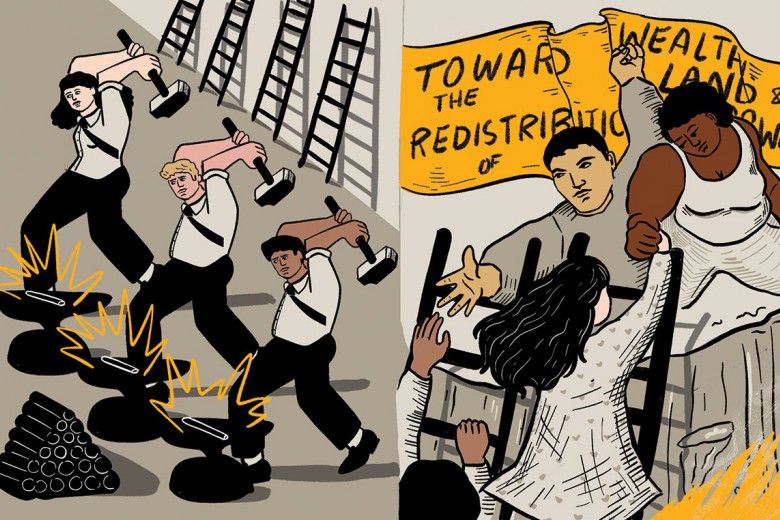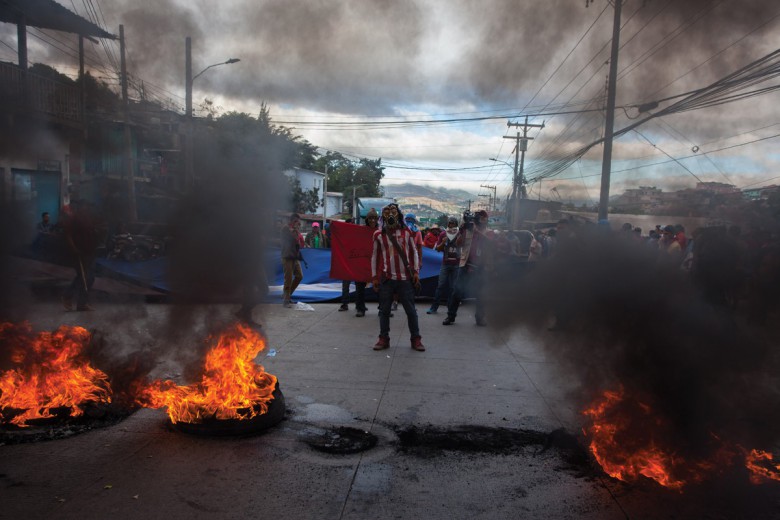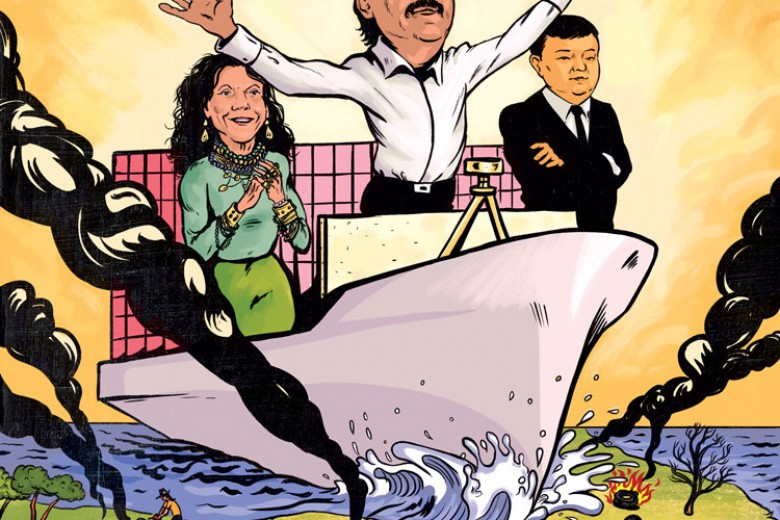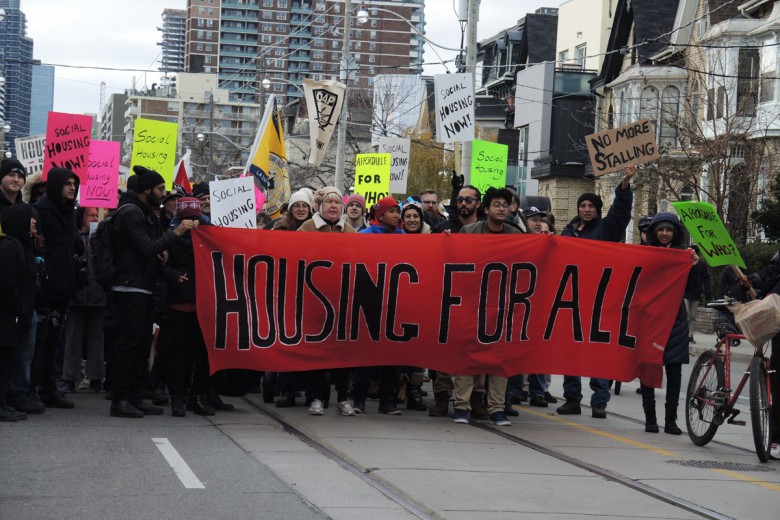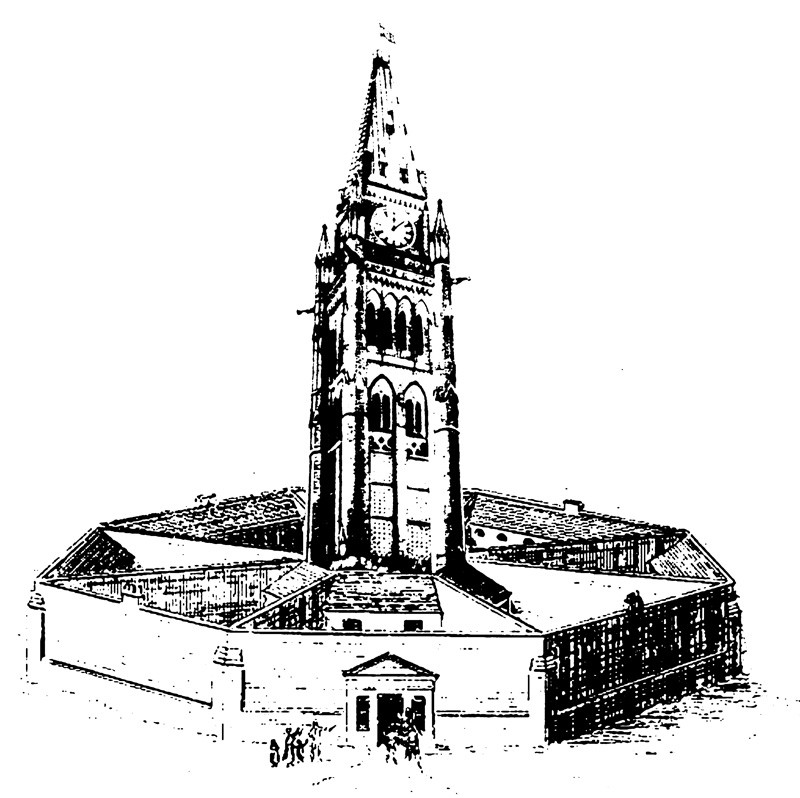
When 27-year-old Daniel Davis was gunned down by a gang member in Scarborough in July 2012, Toronto Mayor Rob Ford announced it was “time to declare war” on gangs. The _Toronto Sun_’s Farzana Hassan took the rhetoric one step further, calling for a “war on drugs” involving “longer prison terms and larger fines” for drug dealing and possession, as well as racial profiling of “certain communities [who] are more prone to drug violence and gang activity.”
Hassan needn’t have bothered: the approach she called for is exactly the one the federal government has been actively pursuing since Stephen Harper’s Conservatives first formed government in 2006. But is targeting the mostly poor, mostly racialized youth who constitute the multi-billion-dollar drug trade’s foot soldiers really the solution to such violence? What of the middle-class kids and other recreational drug users who constitute the majority of the drug trade’s consumers, the bankers who launder its profits, or the politicians who exploit it for political gain?
Prohibition kills
Gun violence and killings linked to the drug trade are still a rare occurrence in Canada, relative to both the U.S. and Mexico. But it’s the same war, the same drugs, and, with Harper’s get-tough-on-crime-while-slashing-the-safety-net approach, we’re entering the same world of pain as our neighbours to the south.
After 40 years and billions of dollars spent, the U.S. drug war has failed to reduce either drug use or drug production. It has funnelled vast amounts of cash and arms to criminal gangs, security contractors, and police and military forces, and created the largest prison population in the world. More than 2.3 million people are currently behind bars in the U.S., and the number of them locked up for drug offences exceeds the country’s entire prison population in 1980. Someone is arrested in the U.S. every 19 seconds on drug charges, almost half of them for simple marijuana possession.
Meanwhile in Mexico, whose drug war is fought with American arms and measured in Mexican lives, an estimated 110,000 people have been murdered and 1.6 million more have been displaced by violence in the past six years of drug war escalation.
In both the U.S. and Mexico, by any reasonable measure, the war on drugs has been a disaster. Journalist John Gibler observes in his book To Die in Mexico that “the United States and Mexican governments continue spending billions of dollars on police and military campaigns that have no rival in history in terms of their absolute failure.” But this begs the question: a failure for whom? Canadian journalist Dawn Paley suggests in her article “Drug War Capitalism” that the war on drugs can only be viewed as a failure if we take its ostensible goal at face value. If, instead, the drug war is understood as a calculated, colossal investment in brutal new strategies of social and territorial control, capital accumulation, and militarization, then we must begin to measure it by a different yardstick.
Stateside, civil rights legal scholar Michelle Alexander has argued that the drug war has served as a highly successful Republican divide-and-conquer tactic for manipulating white voters while disenfranchising, on a massive scale, black ones. In her book The New Jim Crow: Mass Incarceration in the Age of Colorblindness, Alexander compares it to the racial segregation regime that ruled the American South from the Civil War to the civil rights movement. “Mass incarceration in the United States [has] emerged as a stunningly comprehensive and well-disguised system of racialized social control that functions in a manner strikingly similar to Jim Crow,” she argues. Alexander points out that the U.S. prison population has risen dramatically since the drug war began in earnest in the early 1980s, and this mass incarceration has overwhelmingly targeted people of colour, who constitute 70 per cent of the U.S. prison population.
The war on drugs has served the same ends of social control in Mexico, decimating communities that present an obstacle to making the country safe for capital. This is particularly true since President Felipe Calderón came to power in 2006 by a razor-thin victory, marred by massive fraud, in a moment of widespread social unrest.
One of Calderón’s first acts was to deploy the armed forces on Mexican streets, leading to a massive spike in deaths linked to narcotrafficking. The result has been a terrifying climate of impunity in which 95 per cent of deaths linked by officials to gang activity go uninvestigated, while 98 per cent of all reported crimes are never solved. Amnesty International reports that torture by Mexican military and police is widespread, and has risen every year since the U.S. began training Mexican forces in counter-narcotics efforts as part of the Merida Initiative, a bilateral “security cooperation agreement,” in 2008.
State forces and drug cartels, both ruling by force and fear, increasingly come to resemble one another. And human rights defenders, journalists, union leaders, Indigenous activists, and others who stand in the way of profit and power all become targets. In December 2011, the Inter-American Commission on Human Rights reported that Mexican authorities had contracted criminal organizations to kill activists and human rights defenders.
The human rights organization Comité Cerezo, itself under accompaniment protection because of death threats it has received, has documented a significant rise in politically motivated disappearances and extrajudicial executions by state-connected agents since the launch of the U.S.-funded Merida Initiative in 2008.
This is no coincidence. Indeed, it cuts right to the heart of why the drug war continues to drive U.S. policy in the Americas even as the states of Colorado and Washington have voted in favour of decriminalization. As Gian Carlo Delgado-Ramos and Silvina María Romano suggest in a 2011 article in Latin American Perspectives, rising insecurity and violence suit U.S. interests perfectly, serving to foster “a complex balance between stability and instability that maintains the region’s overall dependence and, therefore, its status as a source of U.S. wealth and power.”
Harper’s war
Globally, a growing chorus of voices is calling for an end to prohibition and a shift to treating addiction as a health issue rather than a criminal one. In an open letter to Prime Minister Harper, the Global Commission on Drug Policy – which includes former Canadian Supreme Court judge Louise Arbour, former presidents of Brazil and Switzerland, and businessman Richard Branson – called Canada’s move to further criminalize marijuana in the midst of a global shift in the opposite direction, “very weird.” “Canada is at the threshold of continuing to repeat the same grave mistakes as other countries,” the letter reads, “moving further down a path that has proven immensely destructive and ineffective at meeting its objectives.”
Reviewing Stephen Harper’s domestic and foreign policies, it’s hard not to conclude that the Conservative government is seeking, 40 years later, to replicate wholesale the U.S. strategy both at home and abroad – using the drug war as a pretext to criminalize poverty at home while projecting military power to advance the nation’s economic interests abroad.
Domestically, Harper has pushed through harsher and mandatory minimum sentences for activities related to narcotics production, trafficking, and the gang activity it breeds, while cutting funding for social services, harm reduction, and rehabilitation programs proven to treat addiction and reduce rates of recidivism. Gang membership in prisons has jumped 44 per cent in the past five years, and prison officials are reporting increased prison violence due to overcrowding and increased use of force to quell it. Since the passage of Harper’s latest crime bill in March 2012, provinces are bracing for a massive spike in already overcrowded prison populations. The Canadian Bar Association is predicting greater backlogs in the legal system, and the prison guards’ union is warning of “dramatic” growth in mental health issues among prisoners. Criminologist Justin Piché recently told The Dominion: “The provinces and territories have built or are in the process of building 22 new prisons and 17 additions to existing facilities since 2008 that added over 6,000 new prison beds at a construction cost of nearly $3 billion.”
In 2007, Craig Jones, then director of the John Howard Society, predicted that Harper’s first crime bill would hit marginalized populations hardest. “Police go where the pickings are easiest. It will fall disproportionately on marginalized, mentally ill, and minority youth.” Jones was right. Scott Bernstein and Laura Drake point out in a recent National Post op-ed that “nearly all the population growth in Canada’s prisons over the last decade has been drawn from aboriginal people, visible minorities, people struggling with addictions, and the mentally ill . . . The new sentencing regime for our drug laws will incarcerate even more people from these groups without any regard for their already-disadvantaged position in society.”
Indigenous people will be particularly hard hit. According to an October 2012 report by the UN committee on the rights of the child, Indigenous men in Canada are more likely to go to jail than graduate high school. Indigenous people in Canada make up only four per cent of the population but 22 per cent of the prison population. The same UN report slams Harper’s 2012 omnibus crime bill as being “excessively punitive for children and not sufficiently restorative in nature,” specifically expressing concern at the overrepresentation of Indigenous and black children in the justice system and identifying “serious and widespread discrimination” in services for Aboriginal children, visible minorities, immigrants, and children with disabilities.
Internationally, Harper has positioned Canada as a junior partner in the U.S. drug war on Latin America. Canada wages this war for the same reason the U.S. does: to defend and extend its economic interests in the hemisphere. Stephen Harper himself pointed out while speaking in Colombia in April 2012 that “Canada has more trade agreements in this hemisphere than with the rest of the world combined.” Canada’s dominance in the mining sector is particularly pronounced. Home to 70 per cent of the world’s mining companies, Canada dominates the industry throughout the hemisphere.
Canada’s involvement in the drug war has included sending RCMP officers to train Mexican police forces, deploying coast guard ships to participate in drug interdiction efforts in the Caribbean, and establishing a military “operations hub” in Jamaica “for future operations in the Caribbean.” In April 2012, Harper pledged $25 million over five years to the Canada Initiative for Security in Central America to go toward projects designed “to enhance security and the rule of law and to address issues related to transnational criminal activity in the Americas.” This includes partnering with the government of Colombia “to help strengthen law enforcement systems in Honduras and Guatemala” – hardly three countries exemplary for their safeguarding of human rights.
This funding has thus far received little scrutiny. But we know that similar projects training Mexican forces through the Merida Initiative have coincided, as Comité Cerezo told a Witness for Peace delegation in September 2012, with a spike in torture, abuse, killings, and disappearance of human rights defenders. The same measures are now being replicated in Central America, and Canada is an active participant.
Endgame
Globally, the trade in illicit drugs is worth an estimated $600 billion annually – roughly a third of the entire GDP of Canada. Drugs are big business, and those making a killing are not the targets of your average drug sting. A comprehensive study of the Colombian drug trade found that a whopping 97.4 per cent of the profits of the Colombian drug trade ends up in First World banks, laundered by First World criminal syndicates. And yet, in spite of a series of revelations of bank malfeasance in the handling of suspected drug money, no North American banker has yet gone to jail in the war on drugs.
If the drug war is a tool of social and territorial control and capital accumulation, it’s not enough to simply accuse Harper’s Conservatives of pursuing a misguided strategy. The killers in high places know the consequences of their actions, at home and abroad. Prohibition must end, accompanied by a shift to restorative justice, not retribution; treating addiction as a health issue, not a crime; and an end to Canadian military and financial interventions in the service of resource extraction and finance capital.
The drug war is the endgame of neoliberal capitalism. A self-fulfilling prophecy for right-wing social policy, and a windfall for military and police forces and the banking industry, the drug war is, in essence, the “shock doctrine” writ small. It is responsible for daily acts of spectacular violence that breed fear and increase the power of armed actors, legal and illegal, so as to facilitate the control of marginalized and rebellious populations within and beyond imperialist centres. Social movements across North America and beyond, which are already fighting the fallout from this war on so many fronts, must join forces to end it.


